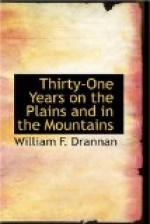Jim was very anxious to have me join him, offering to divide the spoils.
I told him it would be folly for me to accompany him, as he would be able to handle the train alone and would then have the five hundred dollars himself, and furthermore, I did not care for work of that kind that summer, as I would rather return to Taos and buy a band of sheep and settle down, for I thought I had enough money, if properly handled, to make me a good living.
At this Jim laughed heartily and said: “Yes, you’ll settle down with a band of sheep when you are too old to straddle a horse and your eyes too dim to take in an Indian. I have often thought of the same thing,” he continued. “I have a place picked out now about fifteen miles east of Fort Bridger on Black’s Fork, near the lone tree. There is where I am going to settle down after I make this trip. I can then sit in my door and with a good glass I can see Fort Bridger that was named for me and which I feel proud of to-day.”
Jim Bridger made this trip north with Boseman’s train into the valley where the town of Boseman now stands, without the loss of a man or beast on the entire trip, and returning to South Platte, married an Indian woman of the Arappahoe tribe, went to Black’s Fork and took up a ranch within five miles of the lone pine tree. Here he lived with his Indian wife for about five years, when she died, leaving two children, a girl and a boy, which I have been told he sent to school, gave them a good education, and they now live, I think, in the state of Missouri.
CHAPTER XXVI.
Through to Bannock.—A dance of peace.—Fright of the negroes.—A freight train snowed in and A trip on snow-shoes.—Some very tough road agents.
While I was at Fort Kearney another long train of emigrants came along, en-route for Bannock, Montana. They did not know just where Bannock was, and through the influence of Jim Bridger and Gen. Kearney, I was offered employment in guiding them at seventy-five dollars per month, with provisions.
I told them I did not know where Bannock was, but that I could take them to any portion of Montana they asked to go, I was not long making the bargain and making preparations to get started. We went back over the same road as far as Fort Bridger that I had come only a short time before. There was not a person in the entire train that had ever seen a hostile Indian, and very few of them had ever traveled outside of their own state. The most of them were from Indiana, and most of the men had families, and I presume they were fleeing from the draft; that being the time of the late war.
I experienced a great deal of trouble in getting those people organized and trained in a manner to enable us to protect ourselves against the hostile Indians.




